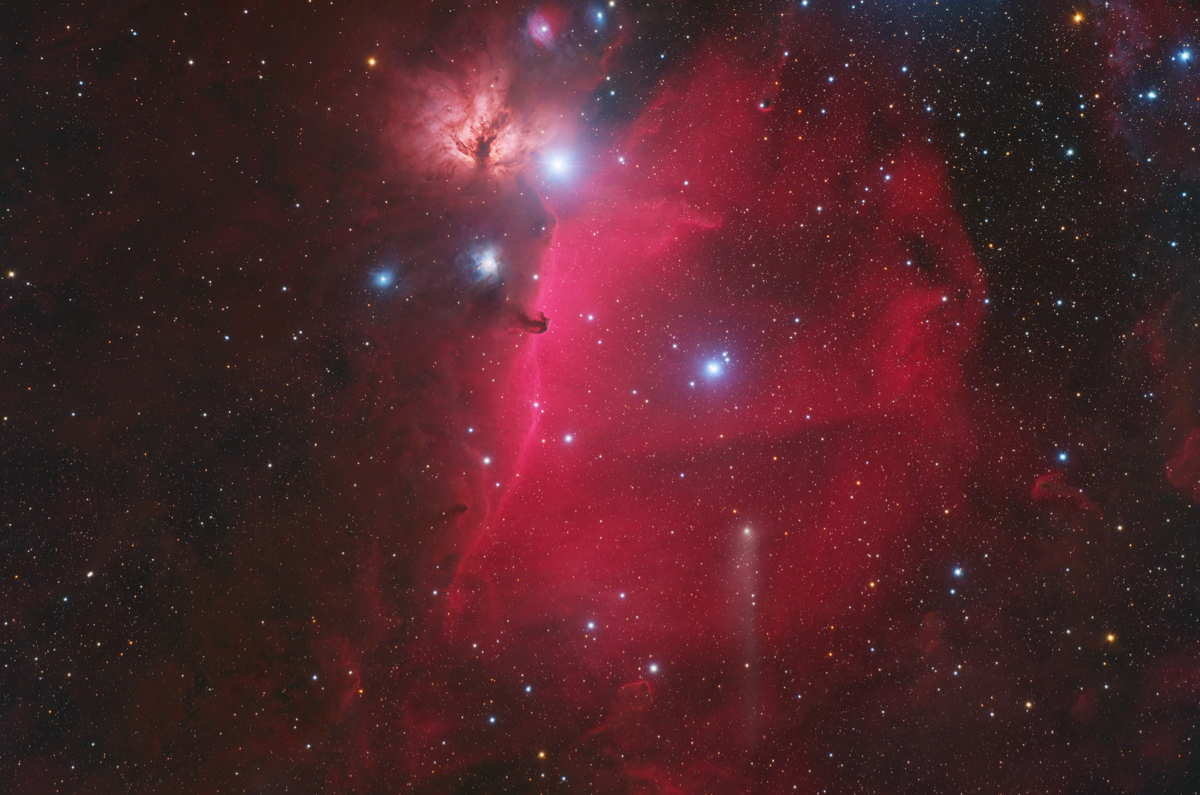
[back] Comet C/2017 K2 (PanSTARRS) in front of IC 434
Big, 100% image version / Große, 100% Bild-Version (9515 x6302, 1.464"/pixel)

|
(c) 2023 All astro photo images are copyrighted. They may not be used or reproduced without explicit written permission from the authors. |
|
0.5 degree |
|
About this Image / Über dieses Bild
| Camera: | Moravian C3-PRO-61000 Mono CMOS |
| Image Type, Orientation: | L-R/HaGB Color Composite, North is at 12:00 |
| Exposure time: | L: 62x120sec, R,Ha,G,B: 29*120 sec. each, (3:02h total, unguided) |
| Exposure date: | December 29th, 30th, 2023 |
| Location: | Capella Observatory South at Kiripotib Astro Farm, Namibia |
| Filter: | Astronomik Deep-Sky Deep-Sky RGB Filter set on Moravian EFW-3L-9-II External Filter Wheel |
| Instrument: | "Callisto", a Takahashi FSQ 106N, 530mm focal length, 106mm aperture, f/5 on modified Losmandy G11 (high res encoders with OnStepX) |
| Photographer: | Rainer Raupach, Josef Pöpsel, Frank Sackenheim |
| Remarks: |
The comet C/2017 K2 (PanSTARRS) was discovered in May 2017 by the 1.8 m
telescope PS1 belonging to the Pan-STARRS project on Maui, Hawaii. At that
time, the comet was still over 16 astronomical units (A.U.) away from the
Sun and classified as a 21st magnitude object. The only comet discovered
farther away before this was C/2010 U3. Its brightness increased to a
maximum of 8 magnitudes by the end of 2022, and it reached its perihelion on
December 19, 2022, at a distance of approximately 1.8 A.U., still outside
the orbit of Mars. At the time of observation, about one year after perihelion passage, the comet was already about 4.6 A.U. from the Sun, comparable to Jupiter's distance from the Sun. The orbital plane, almost perpendicular to the ecliptic at 86.5°, explains the peculiar orientation of the tail towards the south. By the end of December 2023, the apparent position of C/2017 K2 (PanSTARRS) was very close to the HII region IC 434, where the famous Horsehead Nebula is formed by a dark nebula. Also visible in the field are, among others, the Flame Nebula (NGC 2024), the reflection nebulae NCG 2023 and IC 432, the ε Ori Nebula (NGC 1990), and the prominent star Alnitak in the Orion Belt. The impressive background provides a spectacular stage for this comet. A version of the same comet, imaged July 2nd 2022 from Capella Observatory North can be found here. |
|
|
|
| Bemerkungen: |
Der Komet C/2017 K2 (PanSTARRS)
wurde im Mai 2017 mit dem zum Pan-STARRS-Projekt gehörenden 1.8 m-Teleskop
PS1 auf Maui/Hawaii entdeckt. Zu diesem Zeitpunkt befand sich der Komet noch
über 16 A.E. von der Sonne entfernt und ein Objekt der 21. Größenklasse. Bei
seiner Entdeckung weiter entfernt war vorher nur ein anderer Komet (C/2010
U3). Die Helligkeit stieg bis Ende 2022 auf maximal 8 mag an, und der Komet
durchlief sein Perihel am 19.12.2022 in einem Abstand von ungefähr 1.8 AE,
also noch außerhalb der Marsbahn. |
Back to the Comet Overview / Zurück zur Kometen-Übersichtsseite